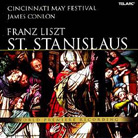May 2004
Although most famous for his piano works, Liszt also composed choral and orchestral music, most notably several symphonic poems, a genre of which he is due most of the credit for inventing. These symphonic poems abandoned the traditional structure of the day and focused on a more visual thematic style. In his latter years, Liszt became a priest and spent much of his time composing religious music. During the last years of his life Liszt began St.Stanislaus, what was to be his last great work. It was to be an oratorio about the conflict and martyrdom of Poland’s patron saint. Unfortunately, Liszt died after finishing only the first and fourth scenes, leaving this work in relative obscurity. This Telarc release is the first complete recording of the two finished scenes and features the May Festival Chorus and the Cincinnati Symphony Orchestra, conducted by James Conlon. The original score has been altered slightly by musicologist Paul Munson. Liszt left the end of the first scene in a piano-vocal score. Munson reconstructed this part in an orchestral fashion befitting the style of the composer’s period. The results are brilliant at times, and frustrating at others. The mood of the completed scenes is dark and brooding. In scene 1, a crowd gathers in front of the cathedral in Krakow and complains of the cruelty of King Boleslaw II. The bishop, with the encouragement of his mother, declares he will confront the king. Jump to scene 4, which depicts the king’s remorse at having murdered the bishop. Missing is the passion and conflict of the argument and actual murder of the bishop, which would have composed the central two scenes. What we are left with sounds much like a symphonic/choral poem which at different times is patriotic, spiritual, and gloomy. The orchestral introduction and interludes are very typical of Liszt’s earlier romantic style. Dark and visual, these symphonic poems are precious finds unto themselves and perhaps constitute the best this disc has to offer. Conductor James Conlon is experienced at conducting Liszt, and it shows. Conlon seems to hold back the players just enough to allow the tone to develop. The solo performances by mezzo-soprano Kristine Jepson and baritone Donnie Ray Albert are quite skillful, matched by the talent of the oft recorded May Festival Chorus. The recording is up to the high standards that Telarc has set as of late. The vast size of the recording venue is reproduced, lending itself to a spacious sound that benefits music of this nature. The chorus sounds wide and deep, with the soloists more specific and forward. One warning! When the deep organ notes hit, about a minute into track 5, tend to your woofers. My REL sub was even given a workout! I really enjoyed this music. It combines tastes of the romantic Liszt with shadings of the era that was to follow. In this way I was reminded of Berlioz, a composer said to have been a great influence on Liszt. I only wish I could hear what symphonic pyrotechnics Liszt had planned for the scenes he never finished. Unrequited it shall remain. GO BACK TO: |
 Liszt - St.
Stanislaus
Liszt - St.
Stanislaus My first encounter
with Liszt was back in college when I was dating a music/piano major. She had been given a
Liszt piece to learn for her upcoming recital, and there was no end to the obscenities
that came from her mouth as she tried to learn that particular piece. Liszt was a
lightning-fingered madman at the keyboard, and anyone who attempted his pieces was quick
to learn respect, if not frustration, for this composer’s virtuosity.
My first encounter
with Liszt was back in college when I was dating a music/piano major. She had been given a
Liszt piece to learn for her upcoming recital, and there was no end to the obscenities
that came from her mouth as she tried to learn that particular piece. Liszt was a
lightning-fingered madman at the keyboard, and anyone who attempted his pieces was quick
to learn respect, if not frustration, for this composer’s virtuosity.